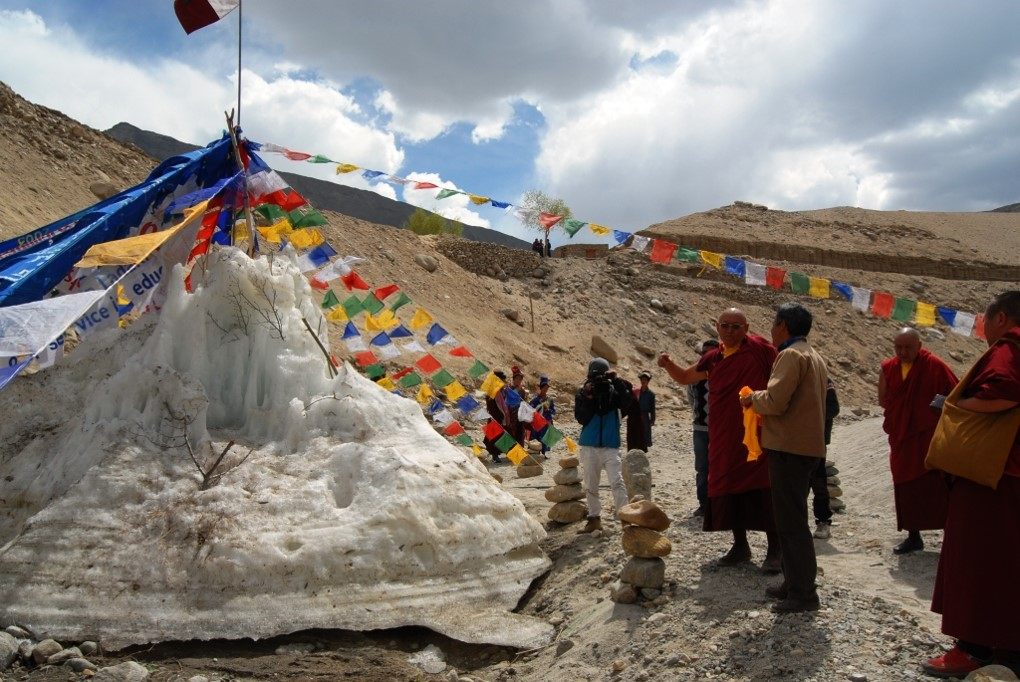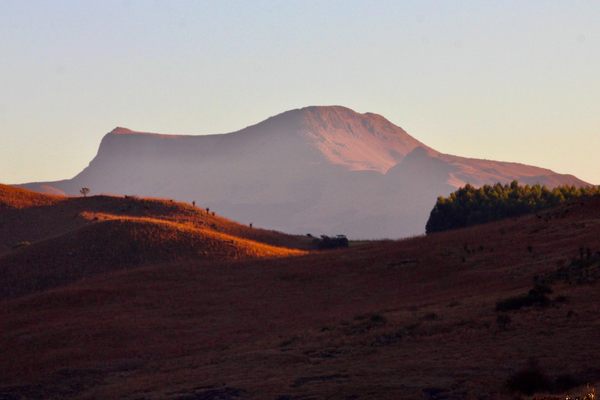India’s Desert Farmers Are Saving Themselves With Artificial Glaciers
Villagers in Ladakh have been building them since the late 1980s.

An Ice Stupa prototype, decorated for a visit from a local monk. (Photo: Ice Stupa Project)
There shouldn’t be so many trees in Fiang.
Like the rest of Ladakh, India’s northernmost region, the village is essentially a cold, mountaintop desert, privy to only about four inches of rain per year. Green stuff has little business there.
But wander over near Phyang Monastery, and there they are—thousands of poplars and willows, thriving in the middle of a barren landscape. Wander a little further, and their benefactor rears up at you: a bumpy, pyramid-shaped mass, stretching several stories into the air and made entirely of ice. It may look like a sculpture, or an accident, but it’s neither. It’s an Ice Stupa, the latest in a long line of artificial glaciers that, for decades, have helped protect the people and plants of Ladakh both from natural scarcity and from the slow, deadly creep of climate change.
The people of Ladakh have always been farmers. For centuries, they had a good system going: after planting crops during the spring rainfall, they used meltwater from far-off glaciers to irrigate them in the summer and fall. Tucked high up in the Trans-Himalayan mountains, the glaciers and surrounding snowpack act as age-old water storage facilities, with millennia of water frozen for later use. When temperatures warm in the summer months, the water trickles down from the glaciers and straight to the thirsty fields, via an elaborate system of hand-dug mud canals.

A mountain view of the village of Kumik. The fields used to extend all the way out to the stone wall that cuts through the landscape. (Photo: Carey Clouse)
Over the past few decades, though, things have gone out of whack. The rainy season dried up. The glaciers began rapidly receding, and temperatures went haywire. Research points to a familiar culprit. “The general thought is that climate change has led to a lack of water when it’s needed,” says Taylor Shippling, an engineer who studies the region.
Enter a unique technology: the artificial glacier. The first was built in 1987, by a Ladakhi engineer named Chewang Norphel. Norphel grew up in Skarra, a farming village about a mile from the capital. For years, he watched his community struggle through dry springs, and rush into planting when the meltwater finally appeared. By the time the true torrents came down, in October and November, growing season was over, and the water spilled uselessly into the Indus River (and out of the village taps, kept open so that the pipes wouldn’t freeze).

Chewang Norphel inspects an artificial glacier in the summer. In winter, this whole landscape will be frozen. (Photo: Carey Clouse)
Norphel hated seeing such waste. So he thought up a solution—what if he created a sort of glacier waystation, perfectly positioned for the village’s needs? If the rush of fall meltwater refroze on its way down, it could stay stored up in the mountains until the thaws began. Then, already close by, it would reach the village by April. Norphel found the sweet spot—14,000 feet up into the Himalayas—and built a series of pipes and retaining walls to divert the water and cajole it into freezing. By the next growing season, Ladakh’s first artificial glacier was in business.
Slowly but surely, the idea caught on. According to researcher Carey Clowes, Ladakh is now home to four working Norphel-style glaciers, as well as several more that are no longer operational (the first one still works). Each is unique to their community. “There is no one model for an artificial glacier,” says Shippling, who recently surveyed the region for them. Some villages go with “snow barrier bands”: stone walls, built at high altitudes, that store up snow that might otherwise scatter, ensuring it piles up into a big water supply. Some plan to adopt the aforementioned ice stupas, recently invented by Sonam Wangchuk, which bring water down from the glaciers in long, high pipes and drip-freeze it right within the village.

Yaks graze near a snow barrier band at Warila Pass. Snow caught behind the stone walls won’t blow away as easily. (Photo: Carey Clouse)
Wangchuk considers his Ice Stupa an improvement on the original—it’s closer to villages, it lasts longer, and its unique shape (which also inspired its name) makes it more compact, he says. Until researchers spend time actually measuring the different artificial glaciers’ water production levels, though, there’s no way to quantify this claim, says Shippling.
But in terms of plain old survival, she says, the most successful glaciers do have one thing in common, namely, extreme community support. “Artificial glaciers are both built and maintained by the communities they serve,” she says, and regardless of how many government agencies, foreign investors, and NGOs may get involved, they live or die based on local engagement. Most villages construct their glaciers through village-wide work parties, everyone hauling stone and digging until the deed is done. These parties generally achieve 100 percent participation, “including children and elders,” says Shippling.
And although people have taken to calling Norphel “The Ice Man,” as though he did it himself, he knows differently. “Without people’s cooperation, you cannot achieve anything,” he told The Alternative, an Indian newspaper, in 2013. In this strange, warming world, glaciers need people as much as people need glaciers.
Naturecultures is a weekly column that explores the changing relationships between humanity and wilder things. Have something you want covered (or uncovered)? Send tips to cara@atlasobscura.com.










Follow us on Twitter to get the latest on the world's hidden wonders.
Like us on Facebook to get the latest on the world's hidden wonders.
Follow us on Twitter Like us on Facebook